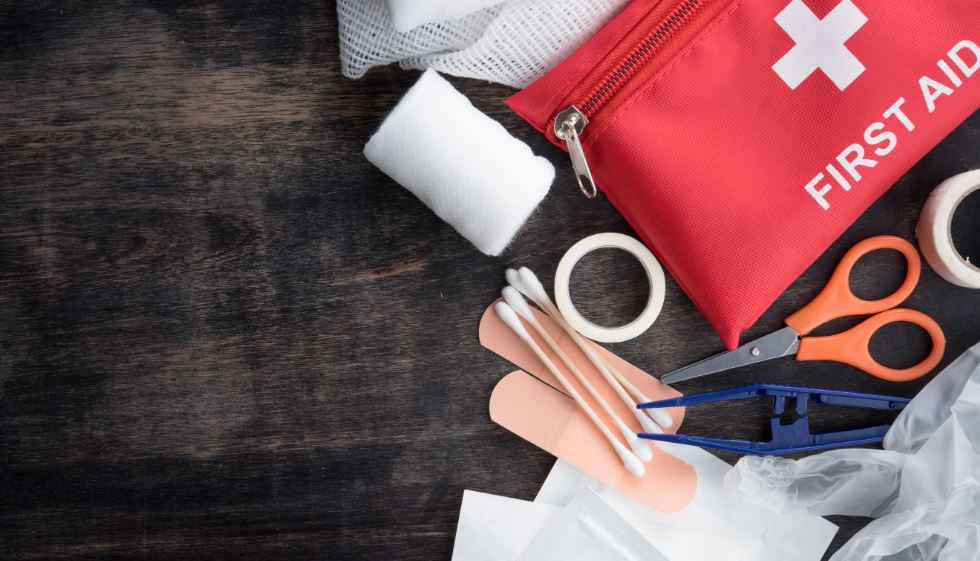Medically reviewed by Michael Menna, DOPrint
Table of Contents
- Basic Items
- Items for Outdoors
- When to Restock
First aid kits are essential to have on hand. Being prepared with a first aid kit allows you to help prevent infections, treat minor injuries like scraped knees and insect bites, and possibly keep someone alive until medical professionals arrive, such as during an allergic reaction.
First aid kits come in many forms, depending on your lifestyle and activities.1 Basic first aid kits should not be confused with survival kits (disaster supply kits), which are prepared for specific environments.2 Mobile first aid kits can be stored in your car, recreational vehicle (RV), or other mode of transportation.
This article discusses everything you need (and don’t need) to build a basic first aid kit.
:max_bytes(150000):strip_icc():format(webp)/GettyImages-1366272668-2cba5e91fb124a58a881790cc73b0fcf.jpg)
Basic Items in a First Aid Kit
You can pick up a stocked first aid kit from your local drugstore. It’s often more cost-effective to source the products and build a kit yourself, and you may be able to make more than one.
Before making a first aid kit, choose the container you’ll keep your kit in. A plastic tackle box or a container for storing pencils or art supplies is ideal. Freezer or fabric storage bags also work well and can take up less space.
Disposable Gloves
Medical gloves can prevent the transmission of certain diseases when treating bleeding wounds.3 Since some people have a latex allergy, having two pairs of latex-free gloves in your first aid kit is best. You may want to carry gloves in various sizes if more than one person may need to wear them.
Antiseptics
Making sure a wound is properly clean can prevent infections by decreasing the number of germs and bacteria.4 You’ll want to add a range of cleaning items to your kit, which include:1
- Five antiseptic wipe packets (will not sting when used on open wounds)
- Five alcohol pads (may sting, so best used to clean around an injury)
- Five insect bite swabs
Ointment
Antiseptic ointment continues to keep a wound clean while soothing irritation.5 Choose five antibiotic and two hydrocortisone ointment packets to add to your first aid kit.
Dressings
Dressings are used when applying pressure to a wound to stop bleeding, reduce blood loss, and clean wound ooze.6 Dressings are usually nonadhesive, which is perfect for burns. Include two absorbent compress dressings in your kit.
Gauze
Gauze is a multipurpose first aid supply. It keeps a wound dry, stops bleeding, and pads a bandage. The difference between dressings and gauze bandages is that gauze allows airflow to the wound, and most dressings do not. You’ll want a variety of styles and sizes of gauze in your kit, which can include:7
- Gauze roll bandage about 1.5 inches wide (usually comes in a roller)
- Five medium sterile gauze pads (about 3 inches)
- Five large sterile gauze pads (about 4 inches)
Tape
You’ll want to keep dressings and gauze in place with surgical tape. Not all bandages are self-adhesive. Include one adhesive cloth tape (about 10 yards long and 1 inch wide) in your kit.1
Bandages
Bandages come in two main types: elastic and adhesive. Elastic bandages come in a roll and can wrap a wound like a sprain or address swelling. Adhesive bandages are used after a wound is cleaned and stick to the skin.8 These include:
- 25 adhesive bandages in assorted sizes
- Two triangular bandages
- One roller bandage (about 4 inches wide)
Personal Medical Information
If you’re on specific medication or require special medical care, include that information along with any other backup or emergency necessities.1 Make a list and include:
- Prescription medications
- Emergency phone numbers
- EpiPen (allergic reactions)
- An accurate automatic BP cuff (high blood pressure)
- A pulse oximeter (lung conditions)
- Inhaler (asthma)
Over-the-Counter Pain Relievers
Medications come in handy during an emergency to treat pain and relieve a fever. Be sure to include packets of two packets of Tylenol (acetaminophen) and two packets of Advil or Motrin (ibuprofen).8
What’s the Difference Between Acetaminophen and Ibuprofen?
CPR Barrier
Masks and barriers are used during cardiopulmonary resuscitation (CPR) to stop the spread of germs, bacteria, and infectious diseases.9 Your first aid kit should include one breathing barrier with a one-way valve.1
Ice Pack
You’ll want one instant cold compress or ice pack in your first aid kit to help reduce swelling and alleviate pain.1
Emergency Blanket
Emergency blankets are lightweight and designed to prevent body heat loss while using body heat to warm a person due to hypothermia.1011
Tools
A few essential tools will come in handy to keep everyone safe and as sterile as possible. Some tools include:1
- Tweezers
- Oral thermometer (one without mercury or glass)
- Bandage scissors
- Notepad and pencil
- Plastic bags
First Aid Booklet
You may run into a situation you’re not sure how to handle. A first aid book is a pocket guide to emergency care for cardiac conditions, allergies, and more.1
Where to Store Your First Aid Kit
You want to store your main first aid kit within reach during an emergency, such as in the kitchen or a central location in your house. Avoid places that are exposed to extreme heat or cold.8 Make sure everyone in the house knows where it is. Consider creating a mobile first aid kit that you can store in your car or other mode of transportation.
First Aid Kit Items for Outdoor Activities
If you’re building a first aid kit for hiking, boating, camping, or the like, consider adding these emergency items:110
- Cell phone
- Water
- Canned food
- Imodium (loperamide) for acute diarrhea
- Benadryl (diphenhydramine) for minor allergic reactions
- Hand-crank radio
- Flashlight
- Dust mask
- Whistle
- Local maps
- Soap
- Matches
What to Keep Out of a First Aid Kit
Hydrogen peroxide, used to treat scrapes and burns, has been found to irritate skin and possibly prevent wounds from healing. Instead, stick to soap and water or antiseptic wipes for disinfecting.12
How Often to Restock a First Aid Kit
Experts suggest checking your first aid kit regularly.1 The last thing you want is to reach for the kit and find missing essentials. Check expiration dates and replace supplies every three to six months. After a major injury, restock a first aid kit as soon as possible.
Summary
Storing a well-stocked first aid kit around the home or workspace can keep you and those around you safe during an emergency. Basic first aid kits can be bought prepackaged, or you can make your own with essentials, like antiseptics, bandages, dressings, gloves, medication, and certain tools. Keep a main first aid kit within reach (home or workplace) and build more specific kits for outdoor or travel activities.

